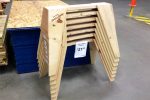The Square in Woodworking: Ensuring Precision and Perfection
In woodworking, a square refers to a tool used to measure and mark right angles (90-degree angles) accurately.
It is an essential tool for woodworkers to ensure that corners are perfectly perpendicular, which is crucial for creating well-fitted joints and accurately aligned pieces in woodworking projects.
A woodworking square typically consists of a ruler or blade and a handle, forming an L-shaped tool.
The handle serves as a guide, allowing the woodworker to place the tool firmly against the edge of the wood while marking or cutting.
By aligning the square with the edges of the wood, woodworkers can draw straight lines perpendicular to the edges, ensuring precise cuts and angles.
Let’s explore the intricate world of squares in woodworking, akin to the detailed breakdown of a tape measure.
The Anatomy of a Square
A woodworking square, whether it’s a carpenter’s square, combination square, or try square, has its own unique anatomy contributing to its functionality and accuracy:
1.) Blade
The flat, metal strip of the square serves a purpose similar to the tape measure’s tape.
It contains precise measurement markings, ensuring woodworkers can measure lengths and angles accurately.
2.) Handle
The handle, akin to the case of a tape measure, provides stability and grip.
It allows woodworkers to hold the square firmly against the wood, ensuring that angles are marked and cut with meticulous precision.
3.) Base
The base of the square, analogous to the hook of a tape measure, is crucial for establishing reference points.
Woodworkers use the base to align the square with the edge of the wood, guaranteeing that their measurements are accurate and consistent.
4.) Markings
Just like the measurement markings on a tape measure, squares have precise etchings or engravings denoting angles and measurements.
These markings guide woodworkers in creating joints, angles, and cuts with utmost accuracy.
5.) Right Angle
The defining characteristic of a square is its ability to ensure a perfect right angle (90-degree angle).
This fundamental feature is what makes squares essential for woodworking tasks requiring accurate corners and joints.
Types of Squares in Woodworking
1.) Carpenter’s Square
This square, resembling a ruler with a perpendicular handle, is the woodworker’s go-to tool for checking right angles.
Its large size and clear markings make it ideal for framing and larger woodworking tasks.
2.) Combination Square
A versatile tool, the combination square combines a ruler and a 90-degree head, allowing woodworkers to measure angles and check squareness simultaneously.
Its adaptability makes it suitable for a wide array of woodworking applications.
3.) Try Square
Smaller and more compact, the try square is perfect for intricate joinery work.
Woodworkers use it to verify the accuracy of right angles and to mark precise lines, ensuring that their pieces fit together flawlessly.
Conclusion
In the hands of a skilled woodworker, the square becomes an extension of creativity and precision.
Its angles and measurements transform raw wood into works of art, embodying the essence of craftsmanship.
So, the next time you admire a finely crafted piece of woodworking, remember the role of the square – the unsung hero that guarantees perfection in every corner and harmony in every joint.

Don Kerr spent many years honing his skills as a DIY woodworker. He finds immense joy in not only creating remarkable pieces but also in generously sharing his knowledge. Connect with him via group.



